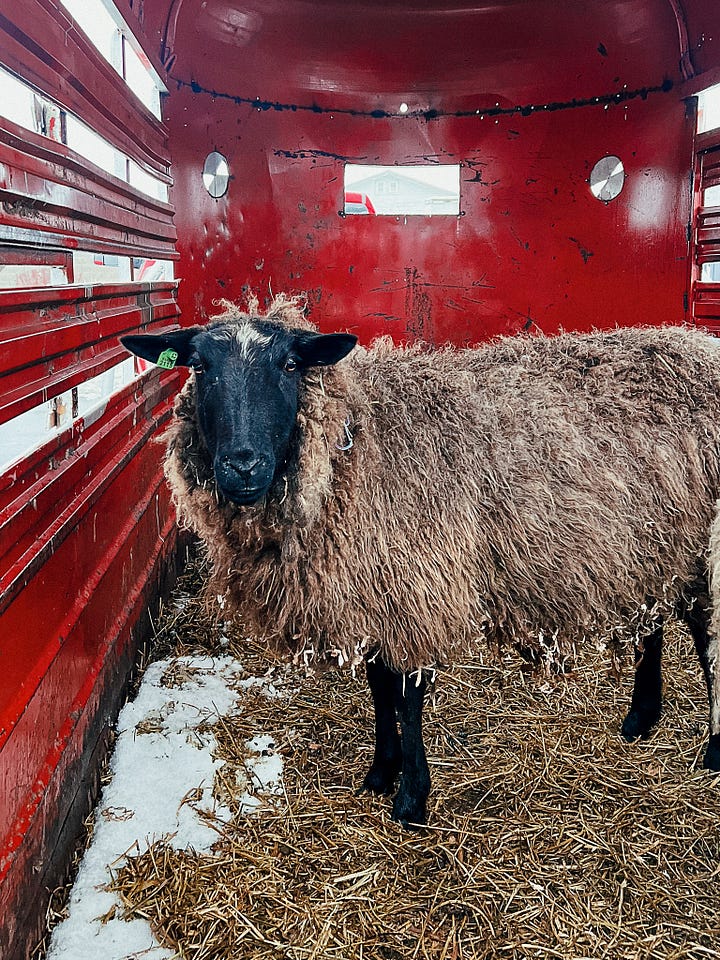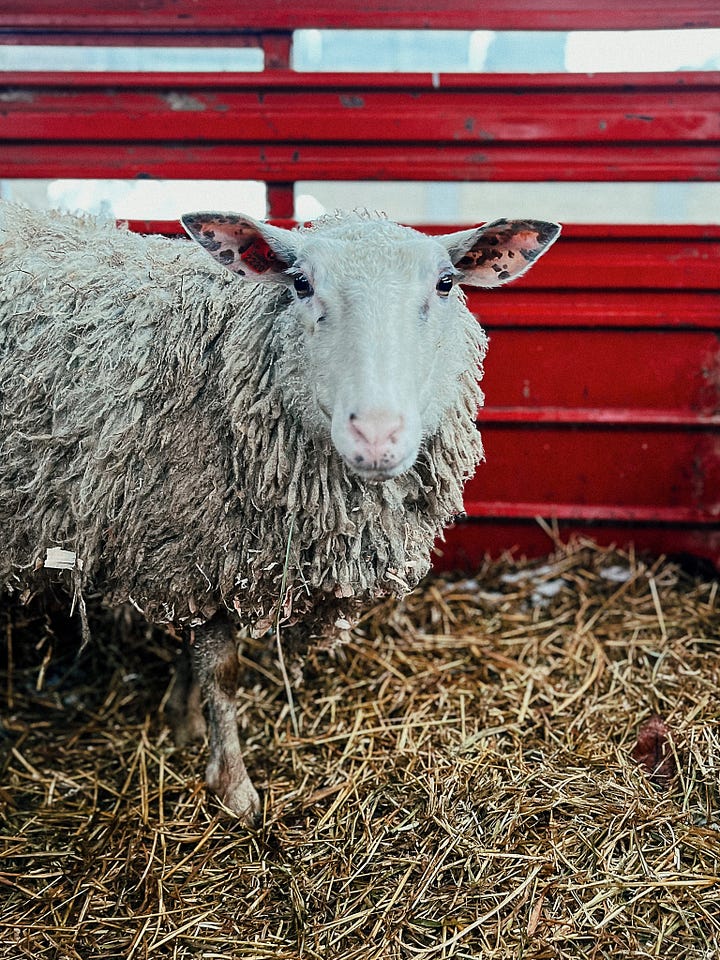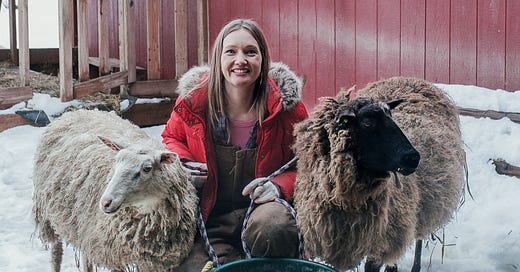Hello my friends,
Frankly, I should be cleaning my house right now. There are needed and practical tasks that demand attention! Dusty bunnies gather in the corners as we speak. Yet the call of this little two and a half acre farm I love so much is louder - and this week is all about listening to those calls. This is the week that my desire of three years was finally realized - it finally happened. New creatures arrived at the farm… any guesses as to what new animal joined our homestead?
For the record, when I do decide to clean my house, I have most incredible cleaning concentrate in my arsenal. Kudos to Branch Basics. If you listen to my podcast, you know how much I delight in cleaning (strange?). We are hard on everything it seems, from countertops to socks. This is a cleaning concentrate that you can use for everything from laundry, to stains, to floors, to windows, to toilets, to showers, to dog kennels (ya, just did this one.) This makes it versatile, cost-effective, and sustainable (I use the glass bottles and just refill). But my point is to tell you that this cleaning concentrate from Branch Basics gets the most grotesque animal stains out of my clothes.
Animal stains (and smells) that I will now be getting from… our new dairy sheep!
AND THE CROWD GOES WILD!


I realize that dairy sheep may not be on everyone’s list of “must haves”, but I am been looking for good breeding stock for years and am so grateful to have finally found the right girls for our farm. I cannot say enough good about Harmony Heritage Farm, another Washington State based family. They’ve been so kind in problem solving, answering questions, and pairing us with the right girls for our needs. If you’re near to me, they’ve got beautiful lambs for sale each spring. You can learn more on their website here.
What breed are they?
East Fresian x Rideau Arcott x Border Leicester x Finn
Ultimately, we really wanted to concentrate on bringing sturdy sheep to the farm for easy of management. Usually, “sturdy” isn’t a word connected to purebreds. “Hybrid-vigor” is a genetic term meant to draw attention to the sturdiness created by crossing two or more breeds together. My genetics professor used to call this the only free lunch a farmer ever gets. For us, a solid crossbreed means sheep that can tolerate 110° summers, -10° winters, hold their condition well, are good mothers without intervention, and have good temperament.
But Shaye… don’t you have a dairy cow already?
Yes. Cece is currently in milk and is lovely as ever. However, one issue we run into time and time again with Cece is getting her bred. This gets a bit into the homesteading weeds, but to breed a cow that is in milk already (which they usually are in a small-scale management like ours), we must:
Bring a bull to our home so that we can continue to milk Cece as normal. This presents obvious issues with size, temperament, feed, and fences. Our fences are not built for bulls who are eager to chase cows or find greener grass. We’ve had issues in the past with bulls I’m not keen to repeat.
Find someone to artificially inseminate Cece. So far, we have not been able to do this locally. I’ve thought about getting certified, but it would require a few weekends away from home and I haven’t been willing to do that yet. I took a class on AI in college but that was many moons ago and I would need a serious refresher course to be successful.
Cece could go to a farm with a bull, but that would require someone to milk her daily still OR be willing to take her bull calf with her. This can present it’s own set of problems because calves are not halter trained (typically) and are a bit spunkier than old dairy cows. We’ve also made the mistake of sending a heifer calf with Cece to a farm with a bull, in an attempt to breed Cece, only to have the heifer calf get bred way earlier than she should have.
Point being, there are a lot of management decisions small-holders like us have to make when it comes to breeding and managing livestock. We have to be smart, resourceful, and level-headed about decisions that will ultimately affect our soil, checkbook, and table.
Ooh - and to keep it extra exciting, and to keep us extra humble, the phases and goals are always shifting slightly.
When my children were younger, we were drinking so much milk a dairy cow was the only reasonable option. I weaned my babies directly to raw milk from our first dairy cow, Sally, and she nourished them well for years. I can’t even begin to count how many gallons of milk were consumed - it was a lot.
That was 10 years ago, and in that time, the children have grown significantly. I’m not filling sippy-cups endlessly with milk anymore, so the consumption level has changed. Raw milk is still essential for us - but the demand isn’t as high. That presents its own set of management decisions when it comes to managing a dairy cow. The question becomes:
Do I have the capacity in my schedule to allow of the tasks of fermenting, culturing, and processing “x” amount of milk per day from my dairy cow?
Is that my priority right now?
If I’m being honest, there’s few tasks I enjoy more in the world than being a milkmaid. Again, like cleaning, I absolutely delight in it. But realistically, I’ve had to let go of a few of my precious things over the past few years to create a bit more space for our homeschool schedule, kids’ social desires, church coops, piano lessons, and creativity of their own to chase. We are in the thick of the best and fullest years of our life! I think it’s possible (and wonderful) to have a dairy animal during this time of life. But it’s not a season where I can invest half a day in cheesemaking. I’ll be there again.
Why Sheep
All of these management decisions, coupled with the fact that Cece is almost nine years old now and not currently bred (for reasons listed above), we decided it was finally time to try our hand at dairy sheep.
I talk about this more in this week’s video, but here’s a few bullet points:
We keep a ram year round already. Breeding dairy sheep is a non-issue for us and will require no extra management on our part besides exposing the dairy girls to the ram.
Two dairy sheep require a lot less spring/summer pasture than a cow and her calf. This will allow our dairy animals to have exposure to more pasture on our small farm, thus increasing the quality of their milk.
The two girls we brought to the farm give 1/2 - 1 gallon per day (so 1 - 2 gallons per day total for us). This will be plenty for us to have fresh milk as well as culture yogurt, kefir, and make super quick cheeses like mozzarella or ricotta.
I really want my children to feel a bit more comfortable milking and build up the confidence and skill to do it all by themselves. The boys have learned to milk Cece, but it’s not something we can just send them out to do alone. She’s too big, she has horns, there’s a huge calf to manage, and cows are just big when you’re that small.
We’ve had sheep for over a decade. We already manage 6-20 sheep in our small herd (depending on how many lambs we have and what time of year it is) and they’re an animal that we not only are comfortable with managing, but an animal that we actually love having around.
Now What?
Both the new ewes are due to lamb in just a few days. We’ve made our first management decisions to leave the lambs on for three weeks, after which, we will begin to milk. But more on lambs/milking/scheduling later…
We will continue to milk Cece for the time being until we decide it’s time to dry her up. Ideally, I’d like to send her (dry) to a farm for breeding. After calving nine months later, we could milk if we wanted or just let her raise us a beautiful fat calf for beef or raise us a replacement heifer for the future. Cece has been our pride and joy for eight years now and she will live out all her days on our farm, regardless of what her milking capacity looks like for the season.
Phew. Sorry. That was a lot of words. I guess I have a few passions in life:
Good food
Gardening
All things related to milk
I hope you have a wonderful weekend, my friends. Thank you for being here and learning alongside us!
Cheers,
Shaye






